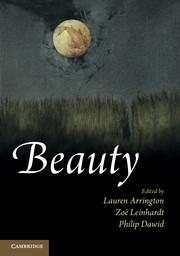Book contents
- Frontmatter
- Contents
- Notes on contributors
- List of figures
- Introduction
- 1 Beauty and truth: their intersection in mathematics and science
- 2 Beauty and the grotesque
- 3 Quantum beauty: real and ideal
- 4 The sound of beauty
- 5 Beauty and attraction: in the ‘eye’ of the beholder
- 6 Beauty and happiness: Chinese perspectives
- 7 Terror by beauty: Russo-Soviet perspectives
- 8 The science and beauty of nebulae
- Index
- References
7 - Terror by beauty: Russo-Soviet perspectives
Published online by Cambridge University Press: 05 June 2014
- Frontmatter
- Contents
- Notes on contributors
- List of figures
- Introduction
- 1 Beauty and truth: their intersection in mathematics and science
- 2 Beauty and the grotesque
- 3 Quantum beauty: real and ideal
- 4 The sound of beauty
- 5 Beauty and attraction: in the ‘eye’ of the beholder
- 6 Beauty and happiness: Chinese perspectives
- 7 Terror by beauty: Russo-Soviet perspectives
- 8 The science and beauty of nebulae
- Index
- References
Summary
Beauty is nothing but the beginning of terror.
Rainer Maria RilkeIt is hard to admit, but even talking about beauty is a challenge to the present status quo, as the subject of beauty, which was earlier so urgent and widely discussed (even if it was in an acutely negative context, as, for example, in the era of modernism) and became the basis of an entire discipline – aesthetics – has lost its former popularity. The subject of beauty became unfashionable, even a sign of aesthetic (and political) retrogression. Why did this happen? There was, of course, a tradition, formulated back in the modernist era that linked beauty to the past, and therefore considered an interest in it to be a manifestation of obscurantism. However, another reason that is much later and much more acutely felt by us today is that beauty was inextricably linked to the terrible totalitarian experience of the twentieth century.
This is why many consider it fundamentally blasphemous to use positive aesthetic categories (and the most hallowed among them, beauty) in the description of totalitarian cultures. Poetry, and beauty right along with it, is impossible after Auschwitz. It seems even more impossible, so to speak, during Auschwitz. And was it not right of Umberto Eco simply to omit these dark alleyways of twentieth-century history from his landmark anthology On Beauty: A History of a Western Idea – which is neither a history of art nor a history of aesthetics but rather an attempt to draw on the histories of both these disciplines to define the ideas of beauty that have informed sensibilities from classical to modern times? Starting with the aesthetic ideal of ancient Greece and ending with the beauty of machines, abstract forms, provocation and consumption, Eco does not even mention ‘totalitarian beauty’, as if the revival of Beauty and the production of totalitarian kitsch in Nazi Germany, Franco’s Spain, Stalinist Russia or Eco’s native Italy of 1932 (when he was born) never happened, or as if this painful period of history did not constitute an epicentre of Western history of the twentieth century.
- Type
- Chapter
- Information
- Beauty , pp. 143 - 168Publisher: Cambridge University PressPrint publication year: 2013

